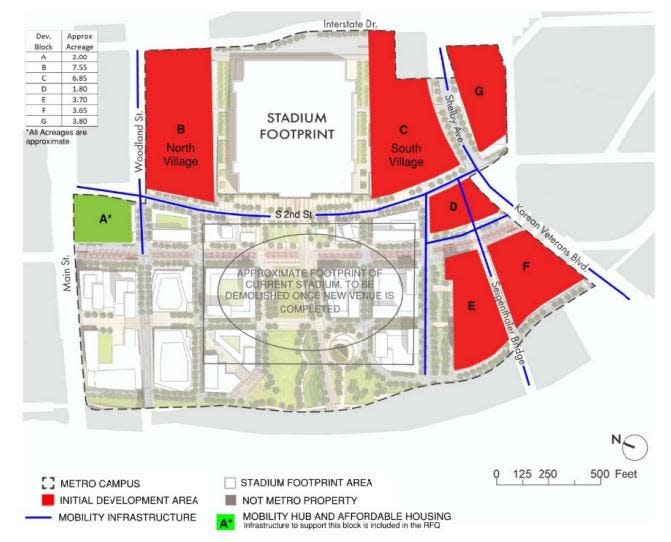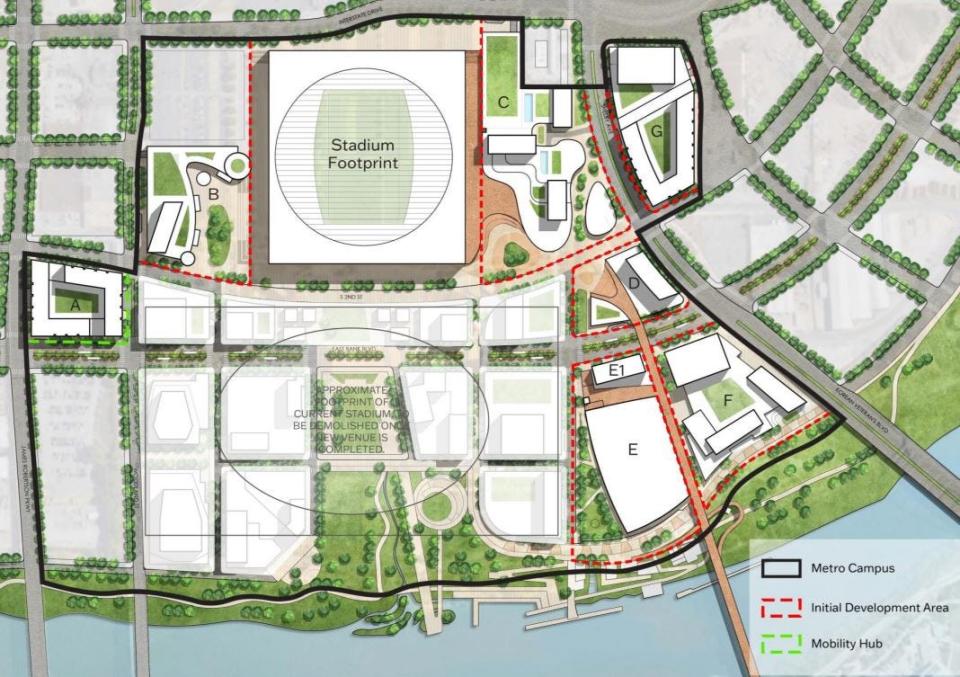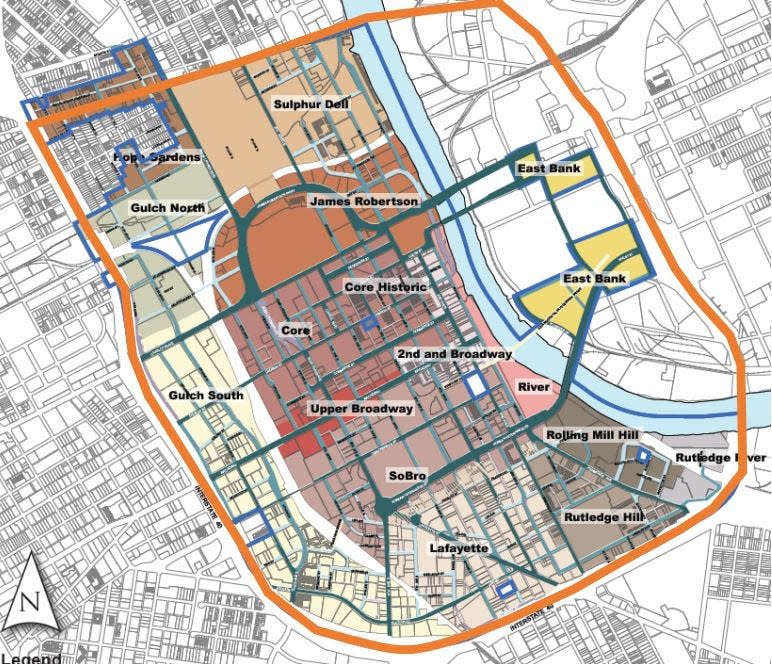Nashville reveals preliminary East Bank plans as development negotiations continue
Early conceptual plans for Nashville's first slice of its new East Bank neighborhood — and potential costs — are emerging as the city's negotiations with its master developer unfold.
Negotiations with The Fallon Company over the initial development of 30 acres of Metro-owned riverfront property are ongoing and details are still subject to change, but a presentation on Monday offered a glimpse into what's on the table for the most expansive project in the city's history.
Discussions so far include a list of anticipated infrastructure needs totaling an estimated $230 million, targets for affordable housing and more details on the future home of the Tennessee Performing Arts Center.
Metro Chief Development Officer Bob Mendes said Monday the presentation represents a "snapshot in time" with details that will likely change before negotiations are finalized. Mendes said sharing these status updates is meant to provide more transparency into the negotiation process.
Final terms have not yet been reached.
Here's what to know.
Roughly 45% of proposed residential units could be affordable
While details are not set in stone until a master developer agreement is finalized, negotiations offer some clarity on the land uses under discussion.
Monday's presentation featured the most detail so far on residential uses, suggesting a minimum 1,550 residential units across at least five residential buildings to be built over the next decade on the 30-acre plot. The discussion includes 600 affordable units in two buildings where 100% of homes are affordable, and 95 affordable units in market-rate buildings (about 10% of an estimated 855 total market rate units).
At first, preliminary plans would prioritize the construction of affordable units, with 300 of the units income-restricted in the initial round of residential construction (within two years of zoning or master developer agreement approval) and all of the proposed 300 units above a new mobility hub to be income-restricted.
Levels of affordability have yet to be determined, but Mendes said he is "pretty confident that we're going to be proud of the mix of levels of affordability."
As part of a "priority for long-term, dedicated, income-restricted housing," affordable residential units would have a 99-year ground lease, something Mendes said is "unprecedented" in Metro history.
Ground-level retail uses would be spread across all buildings, with limited office space available for a 10-year test period. Negotiations to limit the number of hotels on the property are ongoing.
Infrastructure costs could top $227 million
A preliminary tally of the infrastructure needs for the 30-acre initial development zone total $227.4 million, including soft costs like engineering and architectural plans, contingencies and room for price escalation.
Cost sharing between Metro, master developer Fallon and other potential contributors, including TPAC, remain under negotiation.
"The prior administration made a lot of comments about how the East Bank would pay for itself, or the East Bank was going to be 'free to the general taxpayer,'" Mendes said. "The way I would describe it is free to the general taxpayer over a 30-year time horizon, but somebody's got to pay for a bunch of stuff up front."
Early estimates suggest Metro could bear the cost of a 600-space above-ground parking garage estimated at more than $64 million with soft costs considered. Metro's deal with the Tennessee Titans for the construction of the new $2.1 billion Nissan Stadium included a provision requiring Metro to provide the team with a minimum 2,000 parking spaces, with Metro footing the bill for any parking projects necessary to meet that threshold.

Current negotiations place a new TPAC on part of Parcel E, the plot closest to the John Seigenthaler Pedestrian Bridge. Metro would continue to own the land and maintain approval of building design. Lease terms have yet to be finalized.
TPAC and Metro could share the cost of roadway development surrounding the proposed TPAC site. TPAC may also be responsible for the second-most expensive item on the list: an east-west update to the pedestrian bridge.
The parking garage is stadium-related infrastructure that is likely eligible for some of the sales tax derived funding from the Titans stadium deal, but a neighborhood that generates sales tax revenue will have to come first, Mendes said. Metro is exploring which infrastructure elements it may be able to seek reimbursement for once this revenue starts coming in.
Parcel-by-parcel breakdown

Parcel C: Hotels and parking: Because the majority of Parcel C is within the 300-foot security perimeter required for NFL events (which Metro agreed to in Titans stadium deal documents), uses like housing are not practicable, Mendes said. This parcel will most likely include a Metro-financed parking garage for Titans use. In the stadium deal, Metro agreed the Titans would receive all parking revenue for event days.
The parcel will also include a "south plaza" that will act as an access point to the stadium, which the Titans will likely pay for. Mendes said the terms for sharing that space on non-event days are still under discussion.
Parcel G: Affordable housing: Mendes said this parcel will be among the first constructed, and will "exceed what Imagine East Bank asked for (in terms of affordable residential units) for the first phase of (East Bank) development."
Parcel E: TPAC and pedestrian bridge updates: Mendes said Parcel E will likely be built first. The existing pedestrian bridge will be "substantially reworked" to stretch over a new East Bank Boulevard and land closer to the stadium, offering pedestrians a means of access without having to cross the boulevard on street level.
TPAC has agreed to limit the size of its building, leaving room for Fallon to develop another structure on the parcel.
State lawmakers recently approved a $200 million grant for the relocation, but TPAC would need to contribute a 20% match to access the funding.
Parcel A: WeGo mobility hub and affordable housing: Parcel A will ultimately be home to a WeGo mobility hub with affordable housing on top, but construction can't begin until the East Bank boulevard takes shape, which requires the demolition of the old Nissan Stadium.
Parcel B: Hotel, parking or retail: Parcel B will first serve as a construction yard as the new Nissan Stadium is being built. Eventually, it will likely be developed into hotel, parking or retail uses because it falls within the 300-foot NFL security perimeter, Mendes said.
Downtown Code could expand across river
The Downtown Code zoning district was established in 2010, and allows Metro to more closely regulate building design and uses. Current discussions include creating an "East Use Area" that would extend the Downtown Code zoning district across the river to encompass the East Bank.

Conditions for buildings in the area could include:
Prohibiting industrial uses
Restricting parking based on urban design requirements
Prohibiting short-term rentals
Restricting the number of bars and their proximity to one another
"The planning department has been lockstep with the Mayor's Office in really internalizing that the goal here is (a) neighborhood, not the middle of Broadway," Mendes said.
What's coming next
Metro aims to conclude negotiations before Nashville's annual budget process begins in May. If the legislation necessary to green-light agreements isn't approved by Metro Council before then, they will be paused until the budget process concludes in June.
The current timeline has legislation for the Master Developer Agreement, a memorandum of understanding with TPAC and any site coordination document changes being presented to Metro Council for consideration in March and April.
Proposed Downtown Code changes and rezoning would go before council this summer.
This article originally appeared on Nashville Tennessean: Nashville reveals early East Bank plans as negotiations continue

